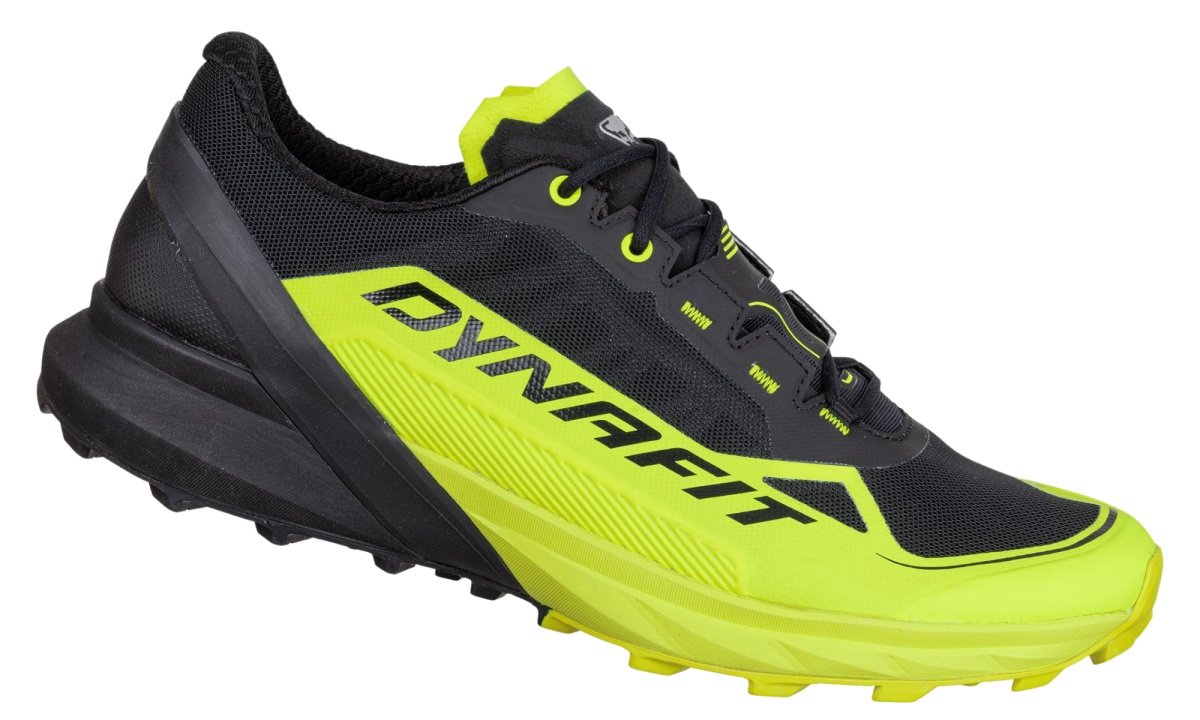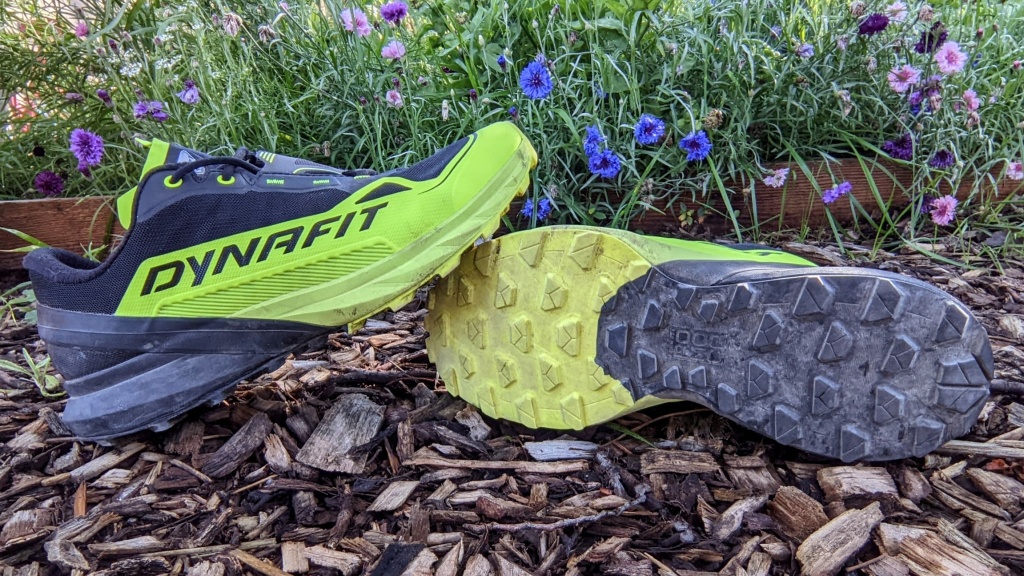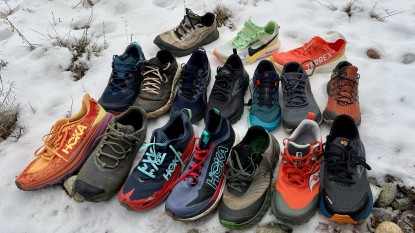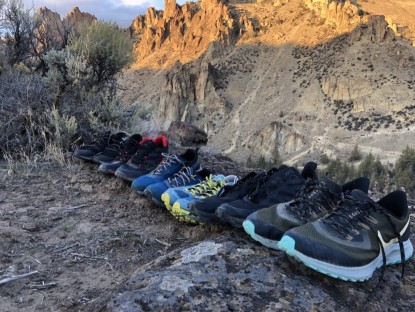Dynafit Ultra 50 Review
Our Verdict
Our Analysis and Test Results
The Ultra 50 is just one of several alpine-focused trail runners available from the outfit well-known for their ski touring products, but well-respected for their full lineup of gear designed for mountain endurance sports. This shoe is designed “for distances of 40 km (25 mi) and longer” — we measured a thick, 33mm stack height in the heels and an aggressive 13mm drop enhanced by a rockered design. Dynafit's proprietary Heel Preloader, a TPU band designed to add support, wraps as a stirrup from the arches to behind the heel pocket.
Foot Protection
For all of its other design flaws, the Ultra 50 still boasts the type of foot protection required to run long distances in the mountains. Despite the higher stack height — which we measured at 33mm in the heel and 20mm in the forefoot — the vertical profile of the shoe tapers nicely to afford a bit of sensitivity in the toes without foregoing any protection. These shoes are surprisingly stiff, particularly through the midfoot, and they are well-cushioned in the heels. The upper is mesh, but most of the upper is covered with a TPU film, offering solid protection across the sides and top of your foot. The Invisible Lacing system incorporated into the tongue is designed to protect your laces from abrasion while doubling as a garage for storage. However, this mesh cover is completely in the way when you are trying to adjust the laces over your instep. More annoying than effective, we would rather have a tight fit than unworn laces. It also left us wondering: when was the last time you sliced through the laces on the top of your foot while running?
Traction
Dynafit markets the Ultra 50 as a “training” shoe to compliment their DNA “race” models. The glide path design on the Pomoca outsoles is designed specifically to reduce deformation energy with impact, resulting in a rolling feel. In our experience, all of this lines up, as this shoe excels at running many miles over rolling, simple terrain and hardpack dirt, like forest roads. But while the rubber is responsive and relatively tacky, these shoes don't grip particularly well. The 4mm lugs are wide and hardly vary at all in size or shape across the entirety of the shoe. While, again, this is fine in some conditions, you don't have any variation in outsole design to help you dig in as you vary your stride to match the trail conditions.
Sensitivity
Even though these shoes stack within the upper band of trail running options, you feel surprisingly in tune with the trails passing underfoot. The trail feel of the Ultra 50 is on-par with shoes measuring one-third of their stack height, offering you the opportunity to find your rhythm in technical terrain. These shoes are thick, but not so much as we would directly compare them to other ultra options in our lineup. Although they are supposed to be designed with maximum shoe volume, the toe box tapers to a point in front of your big toe. This certainly benefits sensitivity, allowing you to push and grip with your first and second toes through technical terrain. But at the same time, this same sense of proprioception quickly fades as we move further back into the midfoot and rear of this shoe.
Stability
As we mentioned above, the Ultra 50 is supposed to be designed with a maximum shoe volume to accommodate the foot swelling that commonly occurs on long runs. Despite the taper in the forefoot, the design and last is certainly wider than many other alpine-specific shoes we have tested. Unfortunately, the midfoot's width and the heel pocket's girth destabilize this shoe entirely. Partly due to the lacing system, but in large part due to the loose fit of the heel pocket, we could not lock this shoe down enough to confidently tackle the world-class alpine terrain found in our backyards. Our foot slipped around so much behind the midfoot that our lead tester nearly rolled his ankle on multiple occasions when running his regular mountain routes.
Comfort and Fit
You might consider the Ultra 50 as a tale of two shoes. A wide, loose fit in the heel and midfoot tapers into a relatively narrow toe box. The result is a shoe that feels entirely different upfront than it does through the tail. Our lead tester — whose relatively narrow foot tends to favor shoes with a tighter last — could not get these shoes to fit correctly. Tying the laces tight enough to lock down his heel and midfoot cut off circulation to his forefoot and toes. Although it is supposed to be designed with a “wide” fit to accommodate foot swelling often encountered on longer efforts, we would not suggest this shoe to any ultra runners based on the counterintuitive fit.
Weight
The Ultra 50 is easily one of the heaviest, albeit most protective, shoes in our lineup. Weighing in at 11.44 ounces per shoe for a men's 10.5 US, it is, on average, three ounces heavier than competitors with a similar build. While it doesn't feel that heavy on your foot, it does feel clunky. We certainly understand why Dynafit qualifies this as a “training” shoe compared to the leaner models in their DNA lineup.
Should You Buy the Dynafit Ultra 50?
Despite our best efforts to push this shoe through our favorite alpine loops, we were inevitably too concerned with its lack of stability (and our livelihood) to run with any semblance of our normal confidence. Although this shoe is supportive enough to qualify as a high-quality trainer, there are simply too many other, better options at this price point for mountain runners.
What Other Trail Running Shoes Should You Consider?
For those looking to push peaks, one of our all-time favorite shoes in alpine terrain is the La Sportiva Bushido II, although those with wider feet should also consider the La Sportiva Karacal. If you only visit the high peaks occasionally and are looking for a lightweight, versatile trail trainer, the HOKA Torrent 3 is as supportive and lightweight as they come.











